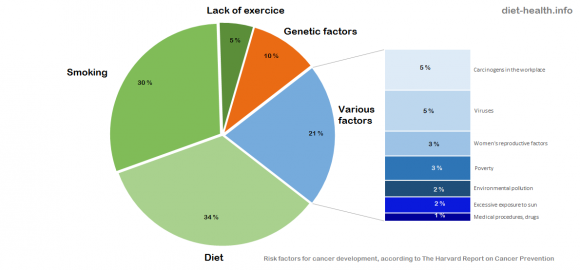Why do people get cancer?
Unhealthy diet and lifestyle account for 69 % of the cancers.

Table of contents
Cancer, also called malignant tumor or neoplasm. For the patient — a terrifying diagnosis. For the doctors — one of the 100 types of diseases where cells proliferate out of control, sometimes spreading rapidly into other parts of the body.
The statistics are more than alarming. In 2012, cancer killed over 8 million people and approximately 14 million new cases emerged. And the number of new cases is expected to rise by about 70 % by the year 2032.1
Most people consider themselves helpless against this dreadful disease. Others, however, take responsibility for their own health and find ways to reverse and prevent it.
But what exactly leads to cancer and what information is scientifically sound and worth taking into consideration? We would like to share the main findings of the “Harvard Report on Cancer Prevention” with you. This report represents the joint efforts of Harvard Medical School and Harvard School of Public Health and includes a thorough analysis of more than 80 million people over a period of ten years. Here are the main findings:

1. Bad genes
In 10 % of the situations, a mutation in a gene is transmitted from the parents to the next generations. Sometimes, the mutation happens during a person’s lifetime (acquired mutation), without being inherited.
There are approximately 50 hereditary cancer syndromes. The most common mutations occur in the BRCA1, BRCA2, TP53, PTEN, and APC genes. These are tumor suppressor genes that normally help repair mistakes in a cell’s DNA, keeping the cells from growing and dividing too fast or in an uncontrolled way and causing them to die if the mistake can’t be fixed.
When such a gene mutation is transmitted from one or both parents to their children, the chances that the children will develop cancer increase. Nevertheless, they do not always get the disease. The expression of the gene causing cancer depends on the pattern of inheritance of the cancer syndrome (autosomal dominant or autosomal recessive) and on epigenetic factors that play an important role in activating or silencing these genes.
2. Dangerous work environment
A total of 119 substances and circumstances have been proven to be responsible for occupational cancer, and more are still being researched.
The occupations that have a higher risk of carcinogen exposure include industrial workers (e.g., welders, painters), health care professionals, miners, refinery workers, manufacturers, construction workers, and auto mechanics. This is a result of high exposure to asbestos fibers, UV radiation, metalworking fluids and mineral oils, diesel engine exhaust, formaldehyde, and other dangerous substances.
3. Viral infections
The six major categories of oncogenic viruses are the Epstein-Barr, human papilloma, hepatitis B, human herpes virus-8, Human T lymphotropic type 1, and hepatitis C virus.3
However, the path from viral infection to cancer outset is very slow, and only a small number of people will actually get cancer, and usually years or decades after the primary infection. Most of the time, the virus infection itself is not sufficient to generate cancer. Other circumstances and characteristics, such as the person’s immune system, genetic predisposition, and diet and lifestyle play a very important role as well.3
4. Women’s reproductive factors
An early onset of menstruation (before the age of 11), having children later in life (around 30s) or not at all, breastfeeding for a period of time shorter than 1 year, and late menopause4 have been proven to increase the risk of cancer in women.
5. Poverty
According to “The Culture of Poverty, Cancer and the Poor” report issued by the American Cancer Society,5 limited financial resources restrict poor people’s access to suitable housing, appropriate nutrition, cancer education, and quality medical care. In addition, the poor are the most vulnerable to environmental factors that cause cancer.
6. Environmental pollution
There are some substances we encounter in our daily lives that we have limited or no control over how they6 affect our health, and this exposure can eventually lead to cancer. Some substances are inhaled (e.g., Radon; the by-products of coal processing, cement, and steel production; industrial dust; and vehicle exhaust7) and others ingested (e.g., soil and drinking water contaminants).
7. Ultraviolet radiation (UV)
Excessive exposure to sunlight or tanning lamps can also lead to skin cancer. According to the WHO, one in every three cancers diagnosed is a skin cancer8, but depending on the other risk factors involved, treatment possibilities and survival rates are quite good.
8. Medical procedures
As ironic as it may sound, medical procedures (e.g., errors, negligence, drug side effects, unnecessary interventions, and treatment complications) are the third cause of death in the US.9
Regarding cancer risk, certain drugs aimed to treat malignant tumors may in some cases cause secondary tumors, while drugs with hormonal activity may increase the risk of some hormonally-based cancers.2
9. Diet and lifestyle
High meat consumption (especially red meat), low consumption of fruits and vegetables, smoking and tobacco use, lack of exercise, alcohol, food additives, and obesity are directly related to more than half of all cancer deaths.
For example, light drinking (up to 1 drink per day) led to 5'000 cases of breast cancer in 2004. Processed meat, sedentarism, refined sugar, and excess weight highly increase the risk for colorectal cancer. For those already diagnosed with prostate cancer, a Western diet (i.e., high meat consumption, refined grains, and high-fat dairy products) causes a significant increase in the mortality rate.10
Paradoxically enough, diet and lifestyle are also the factors people have the most control upon.
Even if a genetic predisposition toward cancer exists, it might never be expressed if the person follows a healthy lifestyle and avoids the other risks as much as possible.
Conversely, there is no single magic nutrient or recipe that will miraculously prevent or cure cancer. To maintain health and fight diseases, the body needs the right nutrients, at the right time, and in the right ratio.
Scientifc references
1. International Agency for Research on Cancer. World Cancer Report. International Agency for Research on Cancer, Lyon, France. March 2003.
2. Rushton L, Hutchings SJ, Fortunato L, Young C, Evans GS, Brown T et all. Occupational cancer burden in Great Britain. British Journal of Cancer, 107(Suppl 1), S3–S7. 2012.
3. Liao JB. Viruses and Human Cancer. The Yale Journal of Biology and Medicine. 2006;79(3-4):115-122.
4. Eaton L. Early periods and late childbearing increase risk of breast cancer, study confirms. BMJ : British Medical Journal. 2002;324(7334):386.
5. Heidary F, Rahimi A, Gharebaghi R. Poverty as a Risk Factor in Human Cancers. Iranian Journal of Public Health. 2013;42(3):341-343.
6. Boffetta P, Nyberg F. Contribution of environmental factors to cancer risk. Br Med Bull (2003) 68 (1): 71-94.
7. Huang Y-B, Song F-J, Liu Q, Li W-Q, Zhang W, Chen K-X. A bird’s eye view of the air pollution-cancer link in China. Chinese Journal of Cancer. 2014;33(4):176-188.
8. Skin Cancer [Internet] World Health Organization 2017 cited 2017 Jan 10. www.who.int /uv/faq /skincancer/en /index1.html.
9. Institute of Medicine (US) Committee on Quality of Health Care in America. To Err is Human: Building a Safer Health System. Washington (DC): National Academies Press (US). 2000.
10. Yang M, Kenfield SA, Van Blarigan EL, Batista JL, Sesso HD, Ma J, Meir J. Stampfer, and Jorge E. Chavarro. Dietary Patterns after Prostate Cancer Diagnosis in Relation to Disease-Specific and Total Mortality. Cancer Prevention Research, June 1, 2015.

Comments